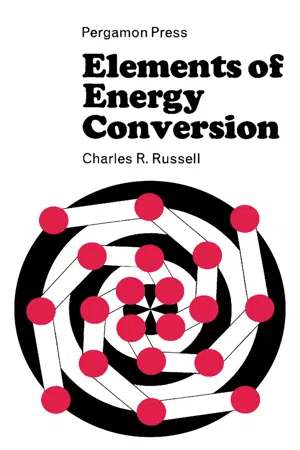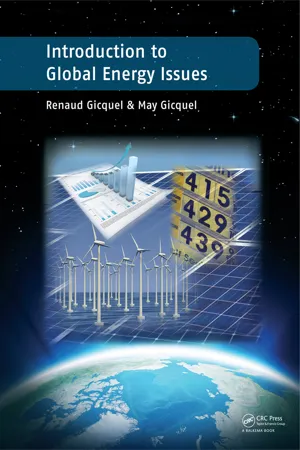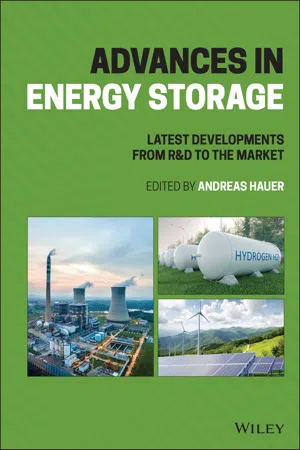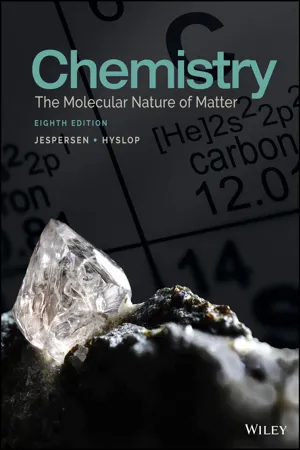Technology & Engineering
Chemical Energy
Chemical energy is a form of potential energy stored in the bonds of chemical compounds. When a chemical reaction occurs, this energy is released or absorbed. It is a fundamental concept in understanding how energy is stored and transferred in various technological and engineering processes, such as in batteries, fuel combustion, and chemical reactions used in industrial processes.
Written by Perlego with AI-assistance
Related key terms
1 of 5
10 Key excerpts on "Chemical Energy"
- eBook - PDF
- H. K. Messerle, Henry G. Booker, Nicholas Declaris(Authors)
- 2013(Publication Date)
- Academic Press(Publisher)
C H A P T E R V I Chemical Energy STORAGE AND CONVERSION 1. INTRODUCTION In a chemical process chemical bonds are broken and new ones made. This reshuffling of chemical bonds involves energy changes and the overall reaction will be, as a rule, associated with a release of energy in various forms. We are then dealing with a Chemical Energy conversion process where some internal energy of the reacting substances is converted into thermal, mechanical, electrical, or radiative energy. Chemical bond energies are of the order of 10 4 to 10 5 cal/mole -1 of reacting substances or, expressed per single bond, they are of the order of 0.5 to 5 eV. This means that relatively large amounts of energy can be packed into a small volume of mass when compared with other means of energy storage unless we go a step further and rupture the nuclear bond. Chemical Energy can be released in disordered form as thermal energy, as we find in straight-out combustion. Such thermal energy may be used either for heating purposes or alternatively it may be converted further into mechanical energy for propulsion purposes as in conventional machinery and rockets. Nuclear energy released during a fission or fusion process involves amounts which are of the order of 10 6 times the energies involved in a chemical reaction. Nuclear energy emerges as kinetic energy of the products and radiant energy, but in power appli-cations the energy released immediately degenerates into random heat energy. In that case nuclear energy can be dealt with in the same way as Chemical Energy. 184 2. THERMOCHEMICAL CONVERSION 185 Chemical Energy may also be converted directly into mechanical, electrical, or other forms. Typical examples are electrochemical cells and photochemical reactions. The same can be said for nuclear energy under special conditions. In this chapter we consider the basic forms of available internal energies and general processes by which this energy can be made available. - eBook - PDF
- Charles R. Russell(Author)
- 2013(Publication Date)
- Pergamon(Publisher)
CHAPTER4 C H E M I C A L E N E R G Y INTRODUCTION Sufficient fuel has been stored by natural processes in coal, oil and gas reserves to meet most energy requirements at present. In addition, other chemical fuels such as hydrogen can be made to store energy for special purposes such as for rapid release of energy in a rocket motor. The Chemical Energy stored in a battery can be released in electrochemical reactions. Similar processes are utilized in fuel cells for direct energy conversion with high efficiency at moderate temperatures. Thus the Chemical Energy stored in fuels can be released by combustion to produce thermal energy for power generation or the Chemical Energy can be released by electrochemical processes directly yielding electrical energy. Chemical Energy is a part of the potential internal energy of molecules, and is associated with molecular and atomic structure. Thermochemistry describes the energy changes accompanying chemical reactions. This science provides a systematic procedure for writing chemical equations including the changes in enthalpy and free energy. The thermochemistry of combustion and electro-chemical processes will be considered in this chapter. HEAT OF REACTION Chemical processes are accompanied by the release (exothermic reaction) or absorption (endothermic reaction) of energy usually as thermal energy. However, in electrochemical processes, electric-140 Chemical Energy 141 al energy may be released or absorbed with only small thermal effects. Thermochemical equations include the chemical reaction and resulting changes in enthalpy or free energy for the reactants and products in their indicated states, as # 2 (g) + K> 2 (g) = H 2 0 (1) AH° = -68.317 kg-cal/g-mole Unless otherwise indicated, the reactants and products are at a pressure of one atmosphere and some standard temperature, T°, such as 298 °K. - No longer available |Learn more
- (Author)
- 2014(Publication Date)
- Academic Studio(Publisher)
The concept of energy is widespread in all sciences. • In the context of chemistry, energy is an attribute of a substance as a consequence of its atomic, molecular or aggregate structure. Since a chemical transformation is accompanied by a change in one or more of these kinds of structure, it is ________________________ WORLD TECHNOLOGIES ________________________ invariably accompanied by an increase or decrease of energy of the substances involved. Some energy is transferred between the surroundings and the reactants of the reaction in the form of heat or light; thus the products of a reaction may have more or less energy than the reactants. A reaction is said to be exergonic if the final state is lower on the energy scale than the initial state; in the case of endergonic reactions the situation is the reverse. Chemical reactions are invariably not possible unless the reactants surmount an energy barrier known as the activation energy. The speed of a chemical reaction (at given temperature T) is related to the activation energy E, by the Boltzmann's population factor e − E / kT - that is the probability of molecule to have energy greater than or equal to E at the given temperature T. This exponential dependence of a reaction rate on temperature is known as the Arrhenius equation.The activation energy necessary for a chemical reaction can be in the form of thermal energy. • In biology, energy is an attribute of all biological systems from the biosphere to the smallest living organism. Within an organism it is responsible for growth and development of a biological cell or an organelle of a biological organism. Energy is thus often said to be stored by cells in the structures of molecules of substances such as carbohydrates (including sugars), lipids, and proteins, which release energy when reacted with oxygen in respiration. - Klaus Brun, Timothy C. Allison, Richard Dennis(Authors)
- 2020(Publication Date)
- Academic Press(Publisher)
Significant global integration of renewable energy sources with high variability into the power generation mix requires the development of cost-effective, efficient, and reliable grid-scale energy storage technologies. Many energy storage technologies are being developed that can store energy when excess renewable power is available and discharge the stored energy to meet power demand when renewable generation drops off, assisting or even displacing conventional fossil- or nuclear-fueled power plants. The development and commercialization of these technologies is a critical step for enabling a high penetration of renewable energy sources.Many mature and emerging energy storage technologies utilize combinations of thermal, mechanical, and Chemical Energy to meet storage demands over a variety of conditions. These systems offer the potential for better scalability than electrochemical batteries. Energy storage demands are complex and the resulting solutions may vary significantly with required storage duration, charge/discharge duty cycle, geography, daily/annual ambient conditions, and integration with other power or heat producers and consumers. This introductory chapter provides details regarding the needs that motivate development efforts for new thermal, mechanical, and Chemical Energy storage technologies; discusses fundamental thermodynamic principles that govern energy storage; and describes the opportunities and challenges for successful development and commercialization of these technologies.1.1: Motivation for energy storage
Energy storage systems help to bridge the gap between power generation and demand and are useful for systems with high variability or generation-demand mismatch. The increasing introduction of renewable power sources into the generation mix results in power availability that is highly variable and poorly matched with demand profiles, thus increasing the high turndown and ramping requirements for baseload power plants that are poorly equipped for this service.1.1.1: Worldwide power generation mix and trends
In 2018 the world consumed approximately 26,641 TWh of electric power [1] , produced by a combination of sources illustrated in Fig. 1 . Based on these data, fossil-based sources accounted for 64.2% of generation, supplemented by 10.2% nuclear power. The remaining ~ 25% was produced by renewable sources including hydroelectric (15.8%), wind (4.8%), solar (2.2%), and geothermal/biomass (2.4% combined). Notably, although wind and solar sources are still a relatively low percentage of the overall energy mix, they are the fastest-growing categories globally and particularly for OECD (Organization for Economic Cooperation and Development) member countries. From 2017 to 2018, the IEA [2] reports overall declines in electricity production in OECD countries from combustible fuels (particularly coal and oil) that are substantially offset by 19.8% and 7.0% growth in solar and wind production, respectively, as shown in Fig. 2- eBook - PDF
- Renaud Gicquel, May Gicquel(Authors)
- 2013(Publication Date)
- CRC Press(Publisher)
• kinetic energy is that of a body in motion: wind energy, water courses, crankshaft, flywheels, etc. Figure 2.1 Different forms of energy. Energy sectors 9 Heat or thermal energy is energy of a body whose temperature is higher than that of its surroundings. There are two forms of heat: sensible heat, involved during a temperature change without a change of state, and latent heat, released (respectively absorbed) with no change in temperature during the solidification (resp. fusion) or the condensation (resp. boiling) of a substance. Heat can be transmitted in three main modes of transfer: conduction and convection, acting by contact, and thermal radiation, which allows for remote transmission. Electromagnetic radiation, which includes thermal radiation, is another form of energy capable of acting at a distance, even without a material medium. Chemical Energy is the binding energy between the molecules of a substance. Hydrocarbons (oil, gas, coal) are forms of Chemical Energy that play a fundamental role in the current global energy balance. Electrical energy is a phenomenon produced by the movement of free electrons in conductors. It is a “noble” form of energy (see below) with three effects (thermal, magnetic and chemical) and a multitude of uses, some of which are specific: lighting, electric motors, electrolysis, induction heating, acquisition, processing and transmis-sion of information, etc. Nuclear energy is the binding energy between the particles that make up the nucleus of an atom. The theory of relativity showed the equivalence of matter itself and energy, according to the famous formula e = mc 2 . Nuclear energy can be released by fission, which involves splitting the nucleus of a heavy atom (uranium, plutonium), or by fusion of light nuclei (hydrogen, deuterium). Today, only fission reactions are controlled. Fusion can as yet only be realized in atomic bombs, although research programs such as ITER aim at controlling it. - eBook - ePub
Cisterns
Sustainable Development, Architecture and Energy
- Alireza Dehghani-sanij, Ali Sayigh(Authors)
- 2022(Publication Date)
- River Publishers(Publisher)
1 ]. So, man’s life has always depended on energy consumption. Changing the food into energy, he sustains his life and does some kind of work.Energy has been defined as the ability to do some work. Work is specified as the force multiplied by the change of distance in line with the force. Energy exists in different forms, the most important of which are as follows [2 ]:- Electrical energy (electricity) is easily transmitted and has many applications like light;
- Mechanical energy which is used in motor-vehicles and agricultural and industrial machines;
- Potential energy like the water behind the dams for generating electricity, irrigation of lands, and supplying water for cities;
- Kinetic energy like the energy of wind to generate electricity or mechanical energy for discharging water from the wells and rivers;
- Chemical Energy which is released in chemical reactions, like the energy produced by burning fossil fuels such as oil, natural gas, coal, wood, agricultural residues, waste, and the like;
- Nuclear energy released in a nuclear reaction which is used to produce electricity in power plants;
- Internal energy which is the total energy of an object at its molecular level;
- Heat energy which is transferred from the object with higher heat to the object with lower heat.
The quality of energy varies from one kind to another, i.e. some kind of energies has a better quality like electrical energy, Chemical Energy, and nuclear energy, whereas ocean’s heat energy and molecular energy have a lower quality [2]. Several factors like the lack of or emerging of new technologies cause changes in the use of energy. Therefore, it can be said that every energy system includes the producing technology and the way it is consumed. The purpose of each energy system is the distribution of energy to the consumer so that the consumer can make the most of it.The services that an energy system offers are carried out by extraction or collection of energy in one or more stages. In fact, energy changes into a different product that is needed by the end-consumers. Of course, these services are the result of the combination of various technologies, investments, and technical knowledge in materials and primary energy sources (primary energy is the kind of energy which has not gone through any conversion process like crude oil). In brief, it is the energy which runs everything. - eBook - PDF
Advances in Energy Storage
Latest Developments from R&D to the Market
- Andreas Hauer(Author)
- 2022(Publication Date)
- Wiley(Publisher)
21.1.1 Storage of Solar Energy in Chemical Bonds Motivating Chemical Energy storage is the fact that compared to batteries, the gravi-metric energy density of fuels such as diesel are 100 times greater [3]. Further, fuels such as diesel, gasoline, and kerosene are readily integrated with our current energy infrastructure and offer the possibility of long term, seasonal storage. The conversion of solar energy into fuels may involve either the direct (photons or thermal energy) or 0 500 1000 1500 2000 2500 0 500 1000 1500 2000 2500 3000 m W , e c n a i d a r r I l a r t c e p S -2 uni03BCm -1 Wavelength, nm Extraterrestrial Air Mass = 1 Air Mass = 1.5 Blackbody at 5777 K (normalized) Figure 21.1 Solar spectral irradiance versus wavelength for extraterrestrial radiation, m = 1 and m = 1.5. For reference the normalized spectral distribution of a blackbody at 5777 K is included. For air mass calculations, α = 0.66 and β = 0.085. 4 Synthesis gas (syngas) is a mixture of H 2 and CO, usually with a H 2 /CO ratio from 1/1 to 3/1. 5 While batteries do constitute a form of Chemical Energy storage, they are more formally an electroChemical Energy storage pathway and will not be discussed in this chapter. 21.1 Introduction 443 indirect (electrons from an alternative storage technology or stored thermal) 6 utiliza-tion of solar energy to drive an endothermic chemical reaction while the sun is plenti-ful. This can be described easily using the example of water dissociation into H 2 and O 2 , as shown below. H O l H g O g k J mol 2 2 2 ( ) ↔ ( ) + ( ) = ( ) -0 5 285 8 1 . . ∆ h (21.2) In the forward direction the reaction is not spontaneous and requires energy to pro-ceed. This energy is equal to the enthalpy of reaction (Δ h ) and for water dissociation is 285.8 kJ per mol H 2 O or 2.962 eV at 298.15 K [4]. When reversing the reaction, the reaction enthalpy may be released to provide heat and drive a thermodynamic cycle such as a fuel cell [5] or heat engine [6]. - eBook - PDF
Chemistry
The Molecular Nature of Matter
- Neil D. Jespersen, Alison Hyslop(Authors)
- 2021(Publication Date)
- Wiley(Publisher)
Chemicals also possess potential energy, which is sometimes called Chemical Energy. When chemical reactions occur, the changes in Chemical Energy possessed by the substances lead to either the absorption or release of energy (as heat or light, for instance). For exam- ple, the explosive reaction between kerosene and oxygen in the main engines of the Falcon-9 rocket, shown in Figure 6.1, produces light, heat, and the expanding gases that help lift the vehicle from its launch pad. Potential Energy An important aspect of potential energy is the way it depends on the relative positions of objects that experience attractions or repulsions toward other objects. For example, a book has poten- tial energy because it experiences a gravitational attraction toward the earth. Lifting the book, which changes its position, increases the poten- tial energy. This energy is supplied by the person doing the lifting. Letting the book fall allows the potential energy to decrease. The lost potential energy is changed to kinetic energy as the book gains speed during its descent. How potential energy varies with position for objects that attract or repel each other can be illus- trated by magnets depicted in Figure 6.2. When the magnets are held in a certain way, the end of one magnet repels the end of another; we say the “north pole” of one repels the “north pole” of the other. Because the repulsions push the magnets apart, we have to do some work to move them closer together. This causes their potential energy to increase; the energy we expended pushing them together is now stored by the magnets. If we release them, they will push each other apart, and this “push” could also be made to do work for us. Likewise, if we turn one magnet around, the ends of the two magnets will attract each other—that is, the “south pole” of one magnet attracts the “north pole” of the other. Now, to pull the magnets apart, we have to do work, and this will increase their potential energy. - eBook - ePub
- George C. King(Author)
- 2017(Publication Date)
- Wiley(Publisher)
Table 8.1 Various forms of energy and examples of how this energy is stored. The table also gives typical values of energy density and round-trip efficiency for various storage systemsForm of energy Energy storage Energy density (MJ/kg) Round-trip efficiency (%) Chemical Energy Fossil fuels; e.g. coal, oil. 35 – hydrogen gas storage 140 ∼60 Thermal energy Hot water storage 0.13 > 50 Ice storage 0.33 ∼80 Potential energy Pumped hydroelectric 0.001 ∼75 Compressed air storage 0.33 ∼50 Kinetic energy Flywheels 0.04–0.4 ∼80 Electrical energy Supercapacitors ∼0.02 ∼95 Superconducting magnets 0.001a95 Lead-acid battery 0.13 ∼80 Fuel cells ∼2b– a The units of energy density in this case are MJ/L.b Includes the mass of the gas storage tank.Important parameters of any energy storage system include the following:- Capacity – here we include the amount of energy that is stored and the rate at which this energy can be delivered, i.e. the power output.
- Energy density – the amount of energy stored per unit mass or per unit volume.
- Round-trip efficiency – the amount of energy released compared with the amount of energy that was put in.
- The time it takes to switch on the power output.
8.2 Chemical Energy storage
8.2.1 Biological energy storage
By Chemical Energy we mean the potential energy that is associated with the chemical bonds of the molecules of a fuel such as wood or coal. In the case of biological systems, the chemical bonds are formed in the process of photosynthesis and hence are a store of solar energy. A way to release this energy is by combustion, e.g. by burning the wood. In fact, fossil fuels provide a natural store of energy. Moreover, their energy density is high. For example, burning 1 L of oil produces ∼35 MJ of energy. (Similarly, we can say that naturally occurring radioactive nuclei such as 235 U and 238 U are stores of nuclear energy. And as we saw in Chapter 3, the energy density of these radioactive nuclei is extremely high, ∼105-6 - eBook - PDF
- Anco S. Blazev(Author)
- 2021(Publication Date)
- River Publishers(Publisher)
The amount of kinetic energy at a certain time can be expressed as power. In the more practical terms, there are several forms of energy that drive our lives, the main of which are: • Physical (or mechanical) energy is the energy that moves things • Chemical Energy is actually a number of energy types that drive chemical reactions • Electrical energy makes our lights, computers, TVs, etc. electrical appliances work • Thermal energy, or heat, is used to elevate tem -perature of objects • Biomass energy is generated by plants • Heat energy is what we get when burning coal and other fuels • Geothermal energy comes from hot springs deep in the ground • Fossil fuels are the old energy sources; coal, oil and natural gas • Solar energy is the energy we obtain by capturing and converting sunlight • Hydropower is obtained from water turning a wheel, which generates energy • Ocean energy is the energy generated by ocean waves and tides • Nuclear energy generates heat by nuclear reactions • Solar energy comes from the sun and can be con -verted into heat or electricity • Wind energy makes the wings of a wind mill rotate to generate electricity • Transportation energy facilitates moving large loads • Magnetic energy is created by permanent magnets or electromagnets • Sound energy is created by increasing the noise level • Cosmic energy is the diferent types of energy con -tained in the Universe Let’s take a look at some of the major types that would help us clarify the concepts of energy and its use on Earth: Physical Energy Energy exists in its physical forms, albeit it the physical realm it is invisible and immeasurable in its purest form. When another component is added to it, however, such as force, mass, distance, speed, etc., it comes to life, and is very easily measurable. In conjunc-tion with its other components (force and distance) it is truly a physical entity that we use in our daily lives.
Index pages curate the most relevant extracts from our library of academic textbooks. They’ve been created using an in-house natural language model (NLM), each adding context and meaning to key research topics.









